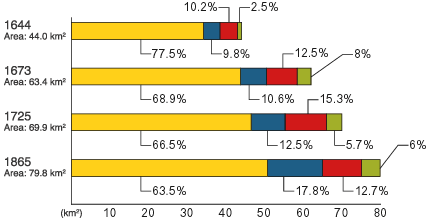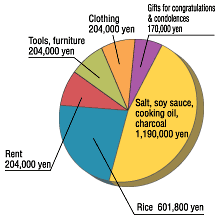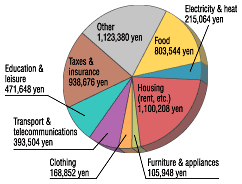 |
|
NIPPONIA No.25 June 15, 2003
|
|
Special Feature*
|
Residential areas for military gentry were less crowded
Edo, purposely developed as the political center of Japan, expanded greatly over time. Almost 70% of the city was occupied by the military gentry. Commoners were approximately as numerous as the military class, but lived on only about 13% of the land.
Urban land area and use

|
| |
Military gentry |
| |
Commoners |
| |
Shrines & temples |
| |
Other |
|
Source: Edo — Development of Japan's Metropolis, by Naito Akira, published by Soshi-sha.
|
|
A carpenter's family in Edo:
annual income and expenditure
Family: Married couple with one child
Housing: Rented apartment
Days worked in one year: 294
Income: 2,698,920 yen
Expenditures: 2,573,800 yen
Percentage expenditure/income: 95%
Source: Bunsei Nenkan Manroku (Annual Itemized Accounts for Bunsei Years, 1818-1830). Edo period figures are converted into today's currency values.
|
 |
|
A company employee's family in Tokyo: average annual income and expenditure
Family: Married couple with one child
Housing: Rented apartment
Days worked in one year: about 240
Income: 5,841,816 yen
Expenditures: 5,320,824 yen
Percentage expenditure/income: 91%
Source: Living Conditions of the People of Tokyo, TMG Livelihood Analysis Survey, FY2001.
|
 |
|
 |